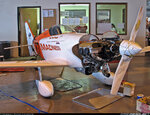Boof69
Well-known member
I originally posted this thread in the project list page. So now I started this build thread in case anyone may be interested in following along with the design process.
I've decided to model this GR-7 Formula one racer. A designer by the name of Robbie Grove created this in the late 80's. There were only two made #55 "Bummers Bullet",and #96 "Blue Streak". Although not a winner the blue streak was a top qualifier in 1989 clocked at 242 mph. The only design info I can find on this one is that it has a high aspect ratio wing for turning stability. Also there's a pic of # 87 Madness (formerly #96)without it's cowling, and a four cylinder engine is clearly visible. Maybe someone could tell it's make just by looking. Also anyone who might be able to make a guess as to the airfoil would be a big help. Anyways its a racer just like the "little tony" found in G3 expansion pack 3. There are some differences though especially at the tail section. This is a very small full size aircraft and I'm not sure what size I should make the RF model. So i'm open to suggestions on that.
I've decided to model this GR-7 Formula one racer. A designer by the name of Robbie Grove created this in the late 80's. There were only two made #55 "Bummers Bullet",and #96 "Blue Streak". Although not a winner the blue streak was a top qualifier in 1989 clocked at 242 mph. The only design info I can find on this one is that it has a high aspect ratio wing for turning stability. Also there's a pic of # 87 Madness (formerly #96)without it's cowling, and a four cylinder engine is clearly visible. Maybe someone could tell it's make just by looking. Also anyone who might be able to make a guess as to the airfoil would be a big help. Anyways its a racer just like the "little tony" found in G3 expansion pack 3. There are some differences though especially at the tail section. This is a very small full size aircraft and I'm not sure what size I should make the RF model. So i'm open to suggestions on that.
Attachments
Last edited:













